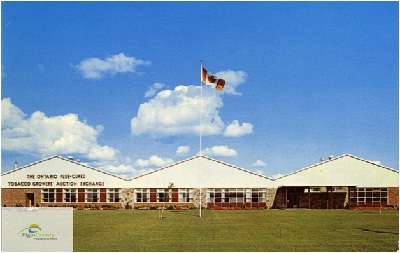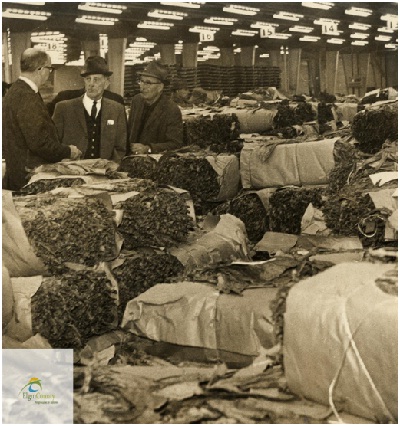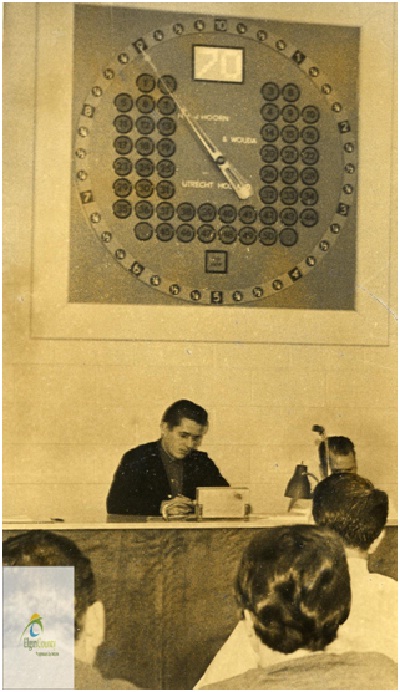Auction Exchange

The Ontario Flue-Cured Tobacco Growers' Auction Exchange near Aylmer, ca. 1975.
Robert Moore Postcard Collection, C6 Sh6 B3 F8 #29.
The auction market usually starts in November, after the harvest of the tobacco. Bales are sent to the auction exchange warehouse and leaves from each bale are pulled for inspection by the buyers. The bales are then put on pallets and weighed. Once a weight has been assigned, a weigh ticket is issued and attached to the pallet and the bales. The weigh ticket contains the farm number, the serial number of the pallet, the weight of the pallet and the number of bales. The farm number is removed from the pallet and sent to the office in order to ensure anonymity during the auction. Next, the pallet is graded by licensed graders hired by the Marketing Board and checked by government graders.

In this January 1966 photograph, freshly-graded tobacco is piled for inspection by buyers at the Ontario Flue-Cured Tobacco Growers' Auction Exchange in Aylmer. Prices continued to rise the previous day following a post-Christmas slump which caused growers to reject more than half the buyers' offers.
St. Thomas Times-Journal fonds, C8 Sh2 B2 F4 14b.
The sale of the tobacco is made on a Dutch Clock. This clock is in a separate room which is sound-proofed. There the buyers bid on a regressive value, starting at a value much higher than the actual value of a particular grade. The clock then drops a quarter of a cent at a time until the buyer makes a bid. When a buyer wants to make a bid, he presses a button that records the price and buyer's number. If a buyer has the same price as another buyer and they wish to purchase a bale, they must raise their price at least a quarter of a cent. After the bid is made, a farmer has a half-hour to inspect their tobacco and accept or reject the bid. If he rejects it, he must sign his weigh ticket and be witnessed by a Board employee doing so. If the farmer rejects the bid he can put his tobacco up for sale again, but if he rejects a second bid, he must take it home and cannot bring it back until his next shipment goes out. If he accepts, then the Marketing Board records the sale and sends out a cheque to the farmer the next day, minus a small per pound fee. The Board then bills the buyer for the amount to be paid at a later date.

The Dutch clock at Ontario Flue-Cured Tobacco Growers' Marketing Board in Aylmer, January 1966. The Dutch clock room was the nerve centre of operations at an auction exchange. Here the buyers decided how much they would pay for the tobacco shipped in by the growers. The growers, in their turn, had to decide whether or not to accept the price. They had 30 minutes after accepting a price to reject a sale.
St. Thomas Times-Journal fonds, C8 Sh2 B2 F4 14c.
There was an auction exchange located in Aylmer. It was one of three auction warehouses opened in 1957 after the establishment of the Marketing Board. However, due to a decline in the amount of poundage being demanded for sale, the Board was forced to close the Aylmer exchange in fall 1986. With this closure, the Board was able to save $250,000 a year in operation costs. About 20 years later, the remaining two auction exchanges in Tillsonburg (closed in 2007) and Delhi (closed in 2009, in wake of the abolishment of the quota system) were also forced to shut their doors.
Tobacco in
Elgin County :
Production :
- Preparation
- Transplanting
- In The Field
- Harvest
- Into the Kiln
- Flue-Curing
- Baling
- Crop Damage
- The Workers